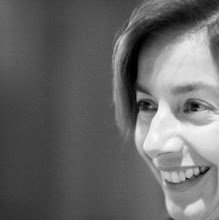Following
last week's talk by Gil on the Anapanasati sutta, I have been meaning to dig deeper and articulate for myself the 16 steps regarding mindfulness of breathing as a full practice. Here is what I understand, based on Gil's talk and reading the Anapanasati sutta:
By focusing one's attention on the breath, one can develop mindfulness, concentration, and insight. We alternate between just being present and changing the experience. Focusing on the breath helps with staying in the present. This requires an active use of our attention. This is not about being passive.
Breathing in long he knows ‘I am breathing in long.’
Breathing in short he knows ‘I am breathing in short.’ [1]
Breathing out long he knows ‘I am breathing out long.’
Breathing out short he knows ‘I am breathing in short.’ [2]
The Buddha says, just know the quality of your breath. Breathing is used as a reference point, that makes it easier to see what the mind does. Also because the attention goes to breathing, one is starving the distractions.
He trains himself ‘breathing in, I experience the whole body.’
‘breathing out, I experience the whole body.’[3]
In the process, we become aware of bodily formations - what is there in the body because of activities of the mind. The various sensations.
He trains himself, ‘breathing in, I calm the bodily formation.’
‘breathing out, I calm the bodily formation.’ [4]
Then we relax and soften those sensations.
He trains himself, ‘I will breath in experiencing joy.’
He trains himself, ‘I will breath out experiencing joy.’[5]
He trains himself, ‘I will breath in experiencing pleasure.
He trains himself, ‘I will breath out experiencing pleasure. [6]
Some energy gets released, and we experience relief. We let ourselves feel the resulting joy and happiness.
He trains himself, ‘I will breath in experiencing mental formation.’
He trains himself, ‘I will breath out experiencing mental formation.’[7]
Same way, we became aware of the bodily formations, we become aware of the mental formations - the effects on the mind of how we use the mind. We feel what is going on in the mind. We look at what is feeding the mental activity: emotions, anxiety, worry. We get to know the overall state of our mind.
He trains himself, ‘I will breath in calming the mental formation.’
He trains himself, ‘I will breath out calming the mental formation.’[8]
Then we relax what goes on in the mind little by little.
He trains himself, ‘I will breath in experiencing the mind.’
He trains himself, ‘I will breath out experiencing the mind.’[9]
He trains himself, ‘I will breath in pleasing the mind.’
He trains himself, ‘I will breath out pleasing the mind.’[10]
We have the experience of soft mind.
He trains himself, ‘I will breath in concentrating the mind.’
He trains himself, ‘I will breath out concentrating the mind.’[11]
He trains himself, ‘I will breath in releasing the mind.’
He trains himself, ‘I will breath out releasing the mind.’[12]
This is an iterative process, we get to watch what happens in the mind and the body when we tighten. We learn how to be aware and to relax. How to liberate the mind. We are not letting go of, but rather letting go into peace, into being more relaxed. We go between knowing something and doing something about it, back and forth. We are breathing with our experience of body and mental states. The breath is what keeps us centered. We are not only focusing on the breath, but we also track what is going on in the present moment.
He trains himself, ‘I will breath in observing impermanence.’
He trains himself, ‘I will breath out observing impermanence.’[13]
He trains himself, ‘I will breath in observing dispassion.’
He trains himself, ‘I will breath out observing dispassion.[14]
He trains himself, ‘I will breath in observing cessation.’
He trains himself, ‘I will breath out observing cessation.’[15]
He trains himself, ‘I will breath in observing relinquishment.’
He trains himself, ‘I will breath out observing relinquishment.’[16]
The last four steps are about cultivating insight. We realize the things we cling to that are not worth clinging to. The thing we cling to start fading away as we become disinterested. Knowing something well enough is sometimes all that's needed to let go.
This in a nutshell was Gil's lecture.
Of course, the question that comes up for me, and that I did not think of asking after the talk, is of how to calm the mental formations? Many times throughout the sutta, the Buddha repeats "having put aside greed and distress for the world". I take it to mean that we take a stance and we decide to drop our habitual way. While sitting, we no longer get hooked into greed, ill will, worry, and sorrow. Instead we choose to dwell in the truth of breath, in and out, in and out, through body sitting still, and we do not linger in the mental formations that cause us unnecessary tensions and suffering. This is how I understand taking refuge in the Buddha, Dharma, and Sangha. This is where (previously verified) faith comes in.








